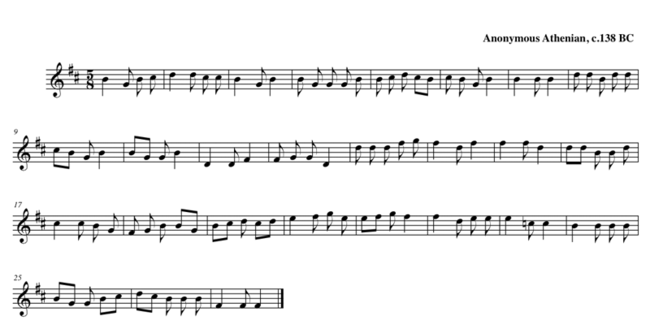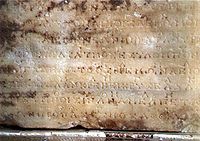
Delphic Hymns
Encyclopedia

Ancient Greece
Ancient Greece is a civilization belonging to a period of Greek history that lasted from the Archaic period of the 8th to 6th centuries BC to the end of antiquity. Immediately following this period was the beginning of the Early Middle Ages and the Byzantine era. Included in Ancient Greece is the...
, which survive in substantial fragments. They were long regarded as being dated circa 138 BCE and 128 BCE, respectively, but recent scholarship has shown it likely they were both written for performance at the Athenian Pythaides in 128 BCE (Pöhlmann and West 2001, 71–72). If indeed it dates from ten years before the second, the First Delphic Hymn is the earliest unambiguous surviving example of notated music from anywhere in the western world whose composer is known by name.
History
Both Delphic Hymns were addressed to ApolloApollo
Apollo is one of the most important and complex of the Olympian deities in Greek and Roman mythology...
, and were found inscribed on stone fragments from the south outer wall of the Athenian treasury at Delphi
Delphi
Delphi is both an archaeological site and a modern town in Greece on the south-western spur of Mount Parnassus in the valley of Phocis.In Greek mythology, Delphi was the site of the Delphic oracle, the most important oracle in the classical Greek world, and a major site for the worship of the god...
in 1893 by a French
France
The French Republic , The French Republic , The French Republic , (commonly known as France , is a unitary semi-presidential republic in Western Europe with several overseas territories and islands located on other continents and in the Indian, Pacific, and Atlantic oceans. Metropolitan France...
archaeologist (Weil 1893; Reinach 1893). Reconstruction of the fragments was facilitated by the fact that the first hymn uses vocal notation, and the second employs instrumental notation (Pöhlmann and West 2001, 70). It was long believed that all that could be told of the composer of the First Hymn is that it was written by an Athenian
Athens
Athens , is the capital and largest city of Greece. Athens dominates the Attica region and is one of the world's oldest cities, as its recorded history spans around 3,400 years. Classical Athens was a powerful city-state...
, around 138 BCE, since the heading of the inscription giving the name of the composer is damaged and difficult to read. However, careful reading of this inscription shows that it cannot be the ethnic "Athenaîos" (from Athens), but rather names "Athénaios Athenaíou
Athenaeus (son of Athenaeus)
Athenaeus, son of Athenaeus was an ancient Greek composer.Athenaeus was an Athenian musician who flourished around 138–28 BC, when he composed the First Delphic Hymn...
" (Athenios son of Athenios) as the composer (Bélis 1992, 48–49, 53–54; Pöhlmann and West 2001, 71). The Second Delphic hymn has been dated to precisely 128 BC; evidently it was first performed in the same year. The name of the composer has also survived, both in the heading of the hymn and in a separate inscription: Limenios
Limenius
Limenius was an Athenian musician and the creator of the Second Delphic Hymn in 128 BC. He is the earliest known composer in recorded history for a surviving piece of music...
, son of Thoinos, an Athenian (Pöhlmann and West 2001, 71). The occasion of the both hymns was the Pythian Festival, held only once every ten years, and according to the former assumption of dating the earlier hymn was probably written for the boys' choir at the Pythian Games
Pythian Games
The Pythian Games were one of the four Panhellenic Games of Ancient Greece, a forerunner of the modern Olympic Games, held every four years at the sanctuary of Apollo at Delphi....
in 138 BCE.

Modern reconstruction performed on computer |
Some of the pitches in this version are mere guesses (as to the readable pitches, see Pöhlmann and West 2001, 62–85).
First Delphic Hymn
Both hymns are monophonicTexture (music)
In music, texture is the way the melodic, rhythmic, and harmonic materials are combined in a composition , thus determining the overall quality of sound of a piece...
(consisting of a single melodic line), but are differentited by their notation. The First Hymn is in so-called vocal notation and it is in the cretic
Cretic
A cretic is a metrical foot containing three syllables: long, short, long. In Greek poetry, the cretic was usually a form of paeonic or aeolic verse. However, any line mixing iambs and trochees could employ a cretic foot as a transition...
(quintuple) meter
Meter (music)
Meter or metre is a term that music has inherited from the rhythmic element of poetry where it means the number of lines in a verse, the number of syllables in each line and the arrangement of those syllables as long or short, accented or unaccented...
throughout (Pöhlmann and West 2001, 70–71, 85). It is in the Phrygian
Phrygian mode
The Phrygian mode can refer to three different musical modes: the ancient Greek tonos or harmonia sometimes called Phrygian, formed on a particular set octave species or scales; the Medieval Phrygian mode, and the modern conception of the Phrygian mode as a diatonic scale, based on the latter...
and Hyperphrygian, with much variation: an archaic pentatonic effect is produced in the lowest tetrachords by avoiding lichanos, while above mese (nominally middle C) there is modulation between a conjunct chromatic tetrachord (C D♭ D F) and a disjunct diatonic one (D E♭ F G), extended by two more chromatic notes, A♭ and A (Pöhlmann and West 2001, 73). In addition to being the earliest surviving substantial fragment of ancient music, the First Delphic Hymn may also have been the longest, perhaps even longer than the Second Delphic Hymn, which runs to 40 lines; unfortunately, the First Hymn does not survive complete (the Seikilos epitaph
Seikilos epitaph
The Seikilos epitaph is the oldest surviving example of a complete musical composition, including musical notation, from anywhere in the world. The song, the melody of which is recorded, alongside its lyrics, in the ancient Greek musical notation, was found engraved on a tombstone, near Aidin,...
, dated anywhere between the 2nd century BCE and the 1st century CE
Common Era
Common Era ,abbreviated as CE, is an alternative designation for the calendar era originally introduced by Dionysius Exiguus in the 6th century, traditionally identified with Anno Domini .Dates before the year 1 CE are indicated by the usage of BCE, short for Before the Common Era Common Era...
, is the earliest surviving complete piece of music).
Exact performance practice is unknown, but Limenius is mentioned in a separate Delphic inscription as a master player of the kithara
Kithara
The kithara or cithara was an ancient Greek musical instrument in the lyre or lyra family. In modern Greek the word kithara has come to mean "guitar" ....
; likely he accompanied a singer or singers.
The First Delphic Hymn falls into two large parts, a Paean
Paean
A paean is a song or lyric poem expressing triumph or thanksgiving. In classical antiquity, it is usually performed by a chorus, but some examples seem intended for an individual voice...
(lines 1–27) and what might have been called a Hyporchema (lines 27–34). The hymn is set in cretic
Cretic
A cretic is a metrical foot containing three syllables: long, short, long. In Greek poetry, the cretic was usually a form of paeonic or aeolic verse. However, any line mixing iambs and trochees could employ a cretic foot as a transition...
s throughout (Pöhlmann and West 2001, 85).

Second Delphic Hymn
The Second Hymn is headed Paean and Prosodion to the God (Pöhlmann and West 2001, 75, 85). It consists of ten sections in all, the first nine in creticCretic
A cretic is a metrical foot containing three syllables: long, short, long. In Greek poetry, the cretic was usually a form of paeonic or aeolic verse. However, any line mixing iambs and trochees could employ a cretic foot as a transition...
metre constituting the paean
Paean
A paean is a song or lyric poem expressing triumph or thanksgiving. In classical antiquity, it is usually performed by a chorus, but some examples seem intended for an individual voice...
, the tenth in aeolic
Aeolic verse
Aeolic verse is a classification of Ancient Greek lyric poetry referring to the distinct verse forms characteristic of the two great poets of Archaic Lesbos, Sappho and Alcaeus, who composed in their native Aeolic dialect...
rhythms (glyconic
Glyconic
Glyconic, , describes a form of meter in classical Greek and Latin poetry. The glyconic line is the most basic form of Aeolic verse, and it is often combined with others....
s and choriamb
Choriamb
In Greek and Latin poetry, a choriamb is a metron consisting of four syllables in the pattern long-short-short-long , that is, a trochee alternating with an iamb. Choriambs are one of the two basic metra that do not occur in spoken verse, as distinguished from true lyric or sung verse...
ic dimeter
Dimeter
In poetry, a dimeter is a metrical line of verse with two feet. Consider Thomas Hood's "Bridge of Sighs:"In poetry, a dimeter is a metrical line of verse with two feet. Consider Thomas Hood's "Bridge of Sighs:"...
s) is the prosodion. Their tonalities are (Pöhlmann and West 2001, 85):
- Lydian
- Hypolydian
- Hypolydian
- ChromaticTetrachordTraditionally, a tetrachord is a series of three intervals filling in the interval of a perfect fourth, a 4:3 frequency proportion. In modern usage a tetrachord is any four-note segment of a scale or tone row. The term tetrachord derives from ancient Greek music theory...
Lydian - Hypolydian
- Hypolydian
- ChromaticTetrachordTraditionally, a tetrachord is a series of three intervals filling in the interval of a perfect fourth, a 4:3 frequency proportion. In modern usage a tetrachord is any four-note segment of a scale or tone row. The term tetrachord derives from ancient Greek music theory...
Lydian - Hypolydian
- Lydian
- Lydian
Recordings
- Musiques de l'Antiquité Grecque: De la Pierre au son. Ensemble Kérylos, directed by Annie Bélis. BNP, 1996. K617-069
- Music of Ancient Greece. OP and PO Orchestra, conducted by Christodoulos Halaris. Orata. ORANGM 2013.
- Music of the Ancient Greeks. De Organographia (Gayle Stuwe Neuman, Philip Neuman, and William Gavin). Pandourion Records, 1997. PRDC 1001.
- Musique de la Grèce antique. Atrium Musicæ de Madrid, Gregorio Paniagua, dir. Harmonia Mundi (France), 1979. HMA 1901015.
External links
- Limenios: Paean and Processional: contains a photograph of the original engraved stone at Delphi.
- Performance of the 1st hymn on lyre by Michael Levy
- Hymne à Apollon, Gabriel FauréGabriel FauréGabriel Urbain Fauré was a French composer, organist, pianist and teacher. He was one of the foremost French composers of his generation, and his musical style influenced many 20th century composers...
's accompaniment for harp, at IMSLP - Ensemble Kérylos is a group which plays ancient Greek music on reconstructions of ancient Greek instruments. Founded by Annie Bélis in 1991.
- Delphi Historical Information, including a description of the hymns
- Synthesised recording used in the game Civilization 3

